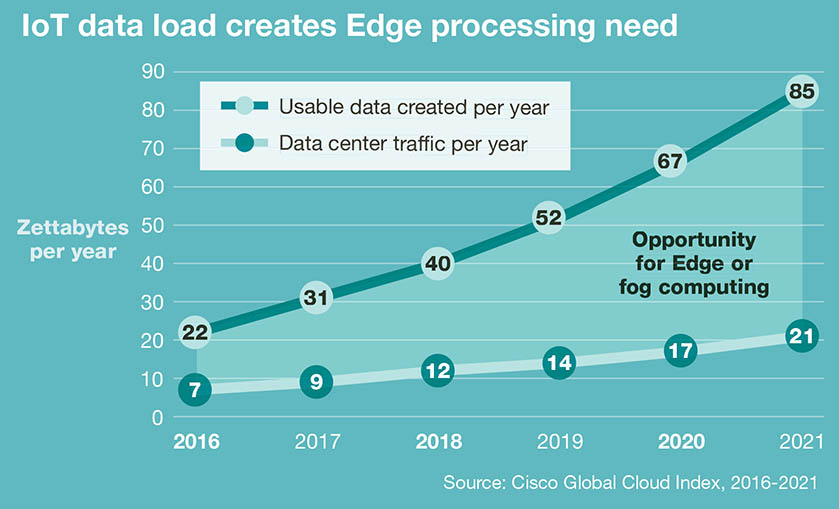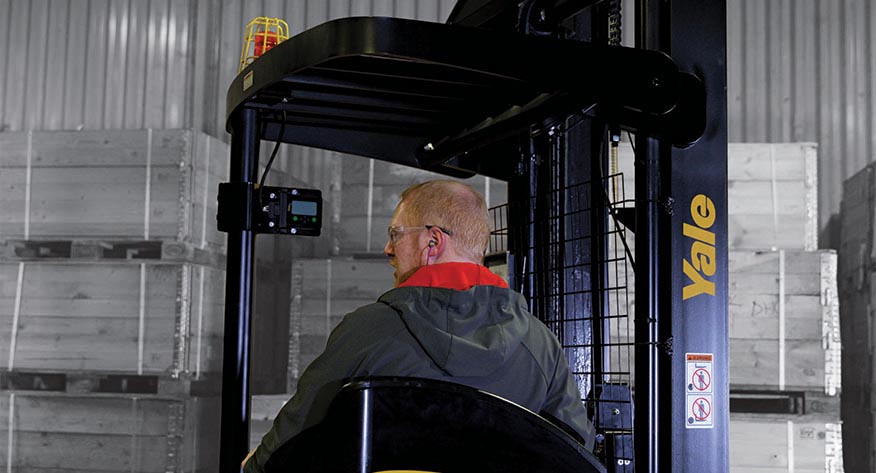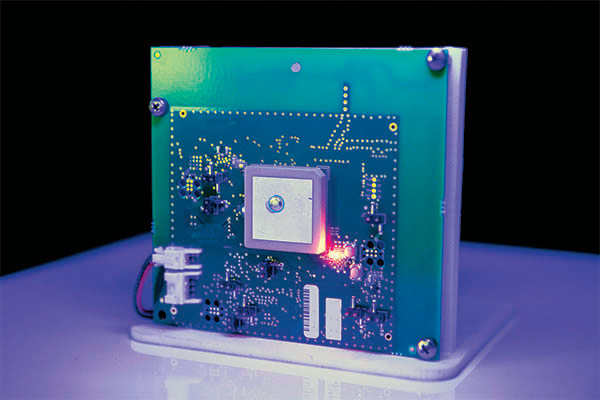The connected warehouse, enabled in part by Internet of Things (IoT) technology, is a concept that’s gaining interest as companies try to cope with e-commerce service level and cost reduction pressures. But, is this concept more vision than reality?
The short answer is that the IoT-connected warehouse is still mostly vision. While some applications, such as lift truck telematics or Cloud-connected temperature sensors, are in use, most distribution centers are not using IoT-connected sensors or equipment. Many automation systems generate near real-time data, but they are usually wired with a controller and into a warehouse control system (WCS).
On the other hand, the IoT-connected DC is materializing. More suppliers are coming up with IoT solutions. These providers include major warehouse automation and materials handling systems vendors who also provide WCS and warehouse execution system (WES) software. One relatively new company—SensorThink—offers an IoT platform aimed at DCs. What’s more, some companies with distribution chains are testing IoT, including Cisco Systems, which has a warehouse innovation lab (see box) within a working DC.
Industrial IoT is about connecting sensors, controllers or equipment to the Internet or private Clouds to aggregate data for analysis. Most vendors say the connectivity piece of IoT needs to be simplified for users, but it’s really the last half of the IoT proposition—the Big Data-style filtering and analysis—that is the key.
“We see the power of IoT as being connected to Big Data and Cloud capabilities because now we can bring together multiple disparate data sources into one place,” says Scott Wahl, vice president of global software for Dematic, a warehouse automation and WES provider.
Carlos Lemus, lead IoT engineer with integrator and WES provider Bastian Solutions, says IoT is coming to warehouses, but warns the technology can be complicated to deploy from scratch, and it is ultimately to be judged by the insights gained. “IoT is almost a misnomer, because it places the focus on connecting to the ‘things,’ but the true value of IoT comes from the data,” says Lemus.
Vendors active
Even if the average warehouse isn’t moving on IoT, vendors are. Dematic, for example, is starting to work with some customers on proof of concepts for IoT-connected sensors or equipment, says Wahl. More generally, Dematic is also adding to its analytics capabilities for purposes such as predictive maintenance.
While Dematic has a WES solution, Wahl says IoT-related analytics wouldn’t just look at conventional WCS level data, but it might also need to tap into data from computerized maintenance management system (CMMS) software, or from supervisory control and data acquisition (SCADA) systems found in a DC. “We are focusing our efforts on solving real-world problems, and part of that is pulling the data together,” says Wahl. “Right now, I would say that within the whole area of predictive analytics, predictive maintenance is probably the one that is most real.”

Of the 85 zettabytes (ZB) of useful data to be generated by people, machines and things by 2021, data centers could process roughly 21 ZB. The delta is where the edge computing need exists.
At SensorThink, an IoT platform provider whose parent company is Tompkins International, an early driver for its platform revolves around pulling together, filtering and cleansing data from various data sources, says Eric Peters, SensorThink CEO. Early clients of SensorThink would use this aggregated data to arrive at a comprehensive view of “building health” and the capacity of a DC’s various systems to support service levels, says Peters. The platform could not only pull in data from IoT-connected sensors or equipment, but also from CMMS, or from systems that monitor electrical power or dock equipment, placing the overall view on one dashboard.
“Building health is about monitoring the $10 million of equipment an operation might have in a building to know what is and isn’t working well today,” says Peters. “The bigger guys with large DC networks might be looking across hundreds of millions of dollars in physical assets in their warehouses, and they are trying to understand, ‘how do I make sure everything is working so that I can get to the next level of productivity?’”
Peters says SensorThink is in the midst of deploying some early customers, but details won’t be announced until later this year. Early uses for the platform, he adds, include building health, asset tracking and predictive maintenance.
Peters agrees that predictive maintenance will be an important use case for IoT, but for the analytical models to work properly, the machine learning involved needs enough data history to arrive at strong predictions.
Asset tracking with IoT can leverage multiple technologies, such as “beacons” that give a constant stream of location data, as well as global positioning feeds from mobile devices. Bastian, for example, is introducing Bluehound Asset Tracker, a small IoT device that tracks the status and location of a pallet. The small tracking unit is placed inside a compartment in a composite pallet, and the solution offers a quick routine to “pair” a pallet to a specific load of goods.

Lift truck telematics and fleet solutions can be implemented to leverage a “data mining Cloud,” making it an IoT-style application.
Through IoT tracking and related analytics that Bastian provides, says Lemus, end user companies can see patterns like heavy traffic “corridors” that may involve excessive movement or touches. “You want to know about unnecessary, repetitious movement,” says Lemus. “The data and analysis from IoT allows you to gain insights you won’t get purely from the human eye.”
Model citizens
While the vendors that are most active in IoT solutions for the warehouse tend to have a WES and systems integration background, generally most vendors say analytics for the connected warehouse will require new forms of analytics either layered on top of WES or in a separate analytics platform. The ability to model complex warehouse environments and tie into many data sources are hallmarks for these solutions.
For example, while SensorThink’s IoT platform can be combined with WES software from Tompkins, Peters points out that an IoT platform needs to take in data from multiple types of systems, not just materials handling controls.
Honeywell Intelligrated, another major warehouse automation provider with WES software, positions its latest WES release as a “clean sheet” solution for managing for smart, connected warehouses. At a recent company event in Dallas, Honeywell Intelligrated leaders said its WES can be combined with Honeywell’s Sentience IoT platform.
Knapp is another materials handling and WES provider addressing management of connected DCs. At Modex 2018, the company will introduce redPILOT, a new Cloud software solution aimed at intralogistics optimization. According to Kevin Reader, director of business development for Knapp, redPILOT is separate software from WES that a Knapp subsidiary has been working on for more than two years.
Cisco Systems’ innovation lab tests IoT in the DC
The notion of Internet-of-Things (IoT) connected warehouses may seem more vision than reality for many companies, but in at least one organization, IoT is being tested in a warehouse environment. Cisco Systems, a provider of networking and other high-tech equipment, is collaborating with key logistics partners to test how IoT and other digital technologies can improve logistics operations.
According to Jack Allen, Cisco’s senior director for global logistics, IoT may not change warehousing overnight, but it will begin to speed up processes though near real-time visibility into the movement of goods, on where workers and assets are, and analytics to crunch the data to see how the operation should adjust.
“Information is going to be so much more available and increasingly real time, enabling warehouses to be much faster and more agile,” says Allen. “Much of the value in logistics isn’t just in moving the goods, but in understanding the information. That means quick answers to questions like, ‘where is my shipment,’ or ‘when will I get my goods,’ or, ‘can this production line keep up with the demand requirement?’”
At a warehouse near Houston run by DB Schenker, one of Cisco’s logistics providers, the two companies have established an “innovation lab.” The 25,000-square-foot lab, says Allen, tests various digital technologies, including IoT technology such as sensors and real-time location tracking, in an actual warehouse setting. The lab began a little over a year and half ago, testing out 15 technologies. Four of these, energy management, facial recognition, augmented reality, and pallet dimensioning, have graduated to pilot programs within Cisco’s network.
While Allen figures such tests put Cisco and its logistics partners ahead of the curve in using IoT in the warehouse, he adds that Cisco is “just getting started” with the benefits that pervasive connectivity and analytics can provide. “When I consider what is possible, we’re just scratching the surface,” Allen says.
The IoT possibilities in a warehouse include real-time location tracking of goods, workers and equipment, notes Allen. For example, location technology built into mobile devices like smart glasses allows for constant visibility over where pickers are, rather than only a rough idea based on their last scan or system-directed pick. Such “hyper-locationing,” when combined with analytics, allows for smarter decisions about what each picker should do next, based on the latest order requirements, while minimizing travel time just as one would with more static assignments.
“With IoT you enable an agile and process-based approach where you don’t need to follow unnecessary steps anymore,” says Allen. “The systems and the analytics are smart enough to determine, ‘you don’t have to do this [step] anymore, it’s better to do this other thing right now. Warehouses will still be geared for efficiency, but I do think processes will be more dynamic. Things will speed up.”
Using IoT in the lab has taken a fair amount of tweaking to make things work, though that is normal with new technology, says Allen. Also, he adds, there will be “levels of maturity” as companies adopt IoT in the warehouse, with some sites using IoT in a limited way, but others rolling out IoT more broadly.
Eventually, Allen believes, IoT visibility and analytics will link up with more traditional warehouse management solutions so that operations can adjust on the fly to changing conditions and to accommodate hot orders.
“In tomorrow’s world, we’ll be able to automatically optimize warehouses and transport lanes more effectively,” Allen says. “Pervasive connectivity will show you that there are lot of people going over here to get this item, so let’s change the put up to make the travel time less onerous. Or, you’ll be able to see that it makes sense to drop a picking requirement to a picker that is already in that aisle. These decisions will be able to happen very quickly. That’s what we think tomorrow looks like.”
The redPILOT software is able to tap into multiple data sources, and can analyze IoT data, says Reader. The software acts as a “control tower” for critical trends, he adds, and incorporates predictive modeling, AI and labor optimization functionality. The initial implementation of the software is focusing on proprietary algorithms and predictive models for bottleneck detection and constraint resolution, he adds.
The redPILOT solution will enable what-if analyses of how a DC, its automation and its people can best meet a given demand requirement. These analytics are becoming more necessary as more DCs need to process a fluctuating mix of e-commerce with more traditional orders. Reader likens the analytics speed needed for intralogistics to the speed of advanced mapping and real-time traffic apps for consumers. With today’s traffic and navigation apps, commuters can instantly learn if their normal commute is delayed, by how many minutes, and also be informed of alternative routes that could minimize delays.
Similarly, predictive analytics for DC should allow users to quickly see different outcomes based on changing factors such as cost, service level or equipment efficiency given the orders that need to be fulfilled. “Analytics should give you a very clear view of your operating costs and your capacity issues, and they need to run in almost real time so you get that feedback and adjust,” says Reader.
Tim Eick, vice president of software and controls development for Swisslog, says software for optimizing increasingly automated, connected DCs should be rooted in a digital model that captures how the DC functions and serves as a foundation for adjusting operations to hit the optimal outcomes. “Our view is to first establish a digital shadow of the warehouse or factory—a model of how the facility works,” says Eick. “You need connectivity to all the [data] elements, but first you need to have that model and view into it within the software so you can see your operation in total. Then you can take that model and begin to predict what the flow will be.”
Toward deployments
It’s not as though IoT is new to DCs. Some DCs with refrigerated storage use temperature sensors to remotely monitor out-of-threshold conditions, according to Kyle Baca, systems engineer with Compliance Control, which offers temperature and humidity sensor kits. The sensors typically communicate on Wi-Fi networks out to Cloud-based storage and reporting software. Not only can the sensors facilitate alerts, says Baca, the data can be used to generate maps that predict seasonal “hot spots” within the storage.
Lift truck telematics and Cloud-based fleet management are another type of solution that can be considered an IoT application when the solution is architected so telematics data is sent to the Cloud. Kevin Paramore, marketing manager for fuel cells and data solutions for Yale says the company’s lift truck telematics and fleet solution can be implemented to leverage a “data mining Cloud,” making it an IoT-style application.
Since the Yale Vision solution debuted in 2014, some 30,000 lift trucks are being managed by the solution, says Paramore. Some Yale Vision functions are more tactical in nature, like facilitating safety checklists, but it can also be used at the enterprise level to analyze if assets are being underutilized. The reports from the solution can also pinpoint areas in a DC where there are more incidents. “By viewing heat maps that show the location of incidents, you can see where the problem areas are and better understand root cause, like a blind spot that could be eliminated,” he says.
The Raymond Corp. also sees its lift truck telematics and fleet management as falling under IoT. Users of Raymond’s solution include Romark Logistics, which uses the system to manage a fleet of more than 50 Raymond lift trucks in its Hazle Township, Pa., warehouse. The system and its modules allow the company to evaluate service history, including costs and repair dates, to assess ways to better manage costs by changing frequently repaired parts or examining whether an environmental issue may be causing the need for repairs.
Most warehouses already have a wealth of real-time data from equipment controls and WCS. This more conventional data foundation, although typically wired, remains valuable. In general, vendors with warehouse analytics position their software as being able to assess data from WCS, as well as IoT data.
The advantage of IoT connectivity is that it allows for a stream of data, rather than infrequent snapshots. A location beacon, for example, gives the operation more real-time knowledge of where a resource is, rather than only knowing the location of the last transaction. “What we are trying to improve on in the industry [with IoT asset tracking] is the granularity of the data,” says Bastian’s Lemus.
Tony Storniolo, vice president of operations with integrator Quintec Integration, notes that IoT technology like vibration sensors can be useful, but most heavy-duty conveyors are able to trigger local “stack light” alerts if a malfunction occurs. Thus for most installations, monitoring alerts and following sound preventative maintenance and spares procurement practices are the “tried-and-true” path to reliability. However, he adds, “as the IoT becomes more prevalent and we move toward next-level automation, we would expect these types of networked things [like sensors] to become more commonly integrated into the conveyor portions of the conveyor handling systems.”
Warehousing operations, of course, are becoming more complicated and fast paced by the day, while the cost of IoT technology like sensors and Cloud infrastructure is coming down. That’s pushing more DC-focused vendors into IoT analytics.
For potential users, the IoT end game is leveraging advanced analytics. That goes beyond the benefits of remote diagnostics. As SensorThink’s Peters concludes, “You have to develop that bed of knowledge about your equipment, but once you have that base, the analytics can predict when failures will occur and prevent them. We are going down a path where two or three years from now, IoT is creating not only intelligent equipment, but intelligent subsystems, which grow into an intelligent system inside of your warehouse.”
Companies mentioned in this article
- Bastian Solutions
- Compliance Control
- Dematic
- Honeywell Intelligrated
- Knapp
- Quintec Integration
- The Raymond Corp.
- SensorThink (a Tompkins International subsidiary)
- Swisslog WDS
- Yale Materials Handing Corp.
Article topics








